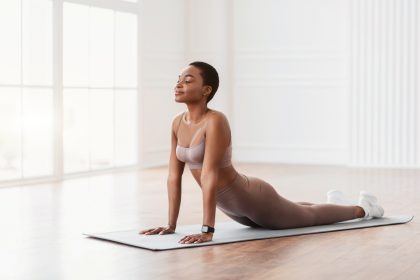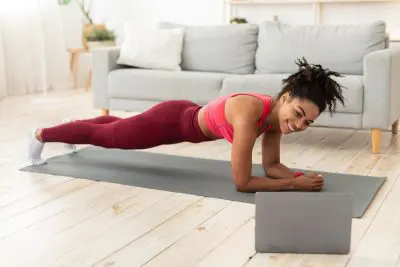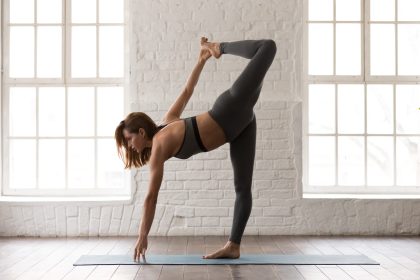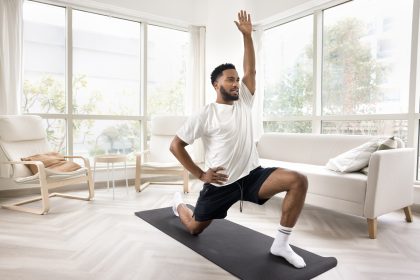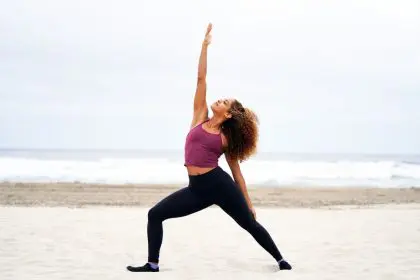These specialized exercises address the unique postural challenges of RA while providing pain relief and improved mobility
Rheumatoid arthritis (RA) creates unique postural challenges that differ significantly from typical alignment issues. As this autoimmune condition attacks joint linings, it often leads to characteristic postural changes including forward head positioning, rounded shoulders, thoracic kyphosis (excessive upper back curvature), and ulnar deviation of the hands. These changes result not only from pain avoidance but also from actual structural modifications to joints and surrounding tissues. While standard posture correction exercises have value, individuals with rheumatoid arthritis benefit most from specialized approaches that address their specific needs while respecting joint limitations. This comprehensive guide explores eight exercises specifically designed to improve rheumatoid posture while minimizing stress on vulnerable joints.
Water-based shoulder rolls
Aquatic exercise provides an ideal environment for addressing the rounded shoulder posture common in rheumatoid arthritis. The buoyancy of water significantly reduces joint loading while providing gentle resistance through all movement planes, creating perfect conditions for postural correction without exacerbating inflammation or pain.
The first technique involves basic shoulder circles performed while standing in chest-deep water. With arms relaxed at your sides, slowly roll both shoulders forward in complete circles for 8-10 repetitions. Then reverse direction, rolling shoulders backward with focus on squeezing shoulder blades together at the back of each circle. This backward direction particularly targets the anterior chest tightness and middle/lower trapezius weakness that contribute to rounded shoulder posture in RA.
The second approach incorporates arm positioning variations. Extend arms straight out to sides at shoulder height, keeping elbows slightly bent to avoid joint stress. From this position, perform small backward circles with arms while maintaining shoulder height. The water’s resistance gently activates the posterior shoulder muscles needed for proper posture while the buoyancy supports the weight of the arms, eliminating gravitational stress on inflamed joints.
The third component involves breathing coordination. Inhale deeply as shoulders roll back, expanding the chest while visualizing the ribcage lifting. Exhale as shoulders roll forward. This breathing pattern enhances thoracic mobility while maximizing lung expansion, counteracting the restricted breathing patterns that often accompany forward posture. Perform these exercises 3-4 times weekly in warm water (84-88°F) for optimal joint comfort. Most individuals notice improved shoulder positioning and reduced tension within 2-3 weeks of consistent practice.
Modified wall slides
Wall slides effectively address both rounded shoulders and forward head posture, common issues in rheumatoid arthritis. However, traditional wall slides often prove too challenging or uncomfortable for those with significant joint inflammation. These modified versions maintain the postural benefits while accommodating RA-specific limitations.
The first modification involves forearm positioning. Stand with back against a wall, feet 6-8 inches from the baseboard. Instead of placing entire arms against the wall (which requires significant shoulder external rotation), position only the back of forearms against the wall with elbows bent at 90 degrees. This adjustment reduces strain on potentially inflamed shoulder joints while still targeting the postural muscles between the shoulder blades.
The second adaptation addresses hand positioning. Rather than forcing hands flat against the wall (which can stress wrist joints affected by RA), keep hands in a neutral position with palms facing inward toward each other. Those with significant wrist involvement may hold soft foam rollers or pool noodle sections in each hand, providing comfortable support while maintaining the exercise’s postural benefits.
The third component focuses on movement range customization. While traditional wall slides involve sliding arms fully overhead, this modified version limits movement to the range where wall contact can be comfortably maintained. Start with small movements, sliding forearms up just a few inches while focusing on maintaining five points of contact with the wall (head, upper back, lower back, forearms, and buttocks). As comfort and mobility improve, gradually increase movement range. Begin with 2 sets of 8 repetitions daily, focusing on quality rather than quantity. Most people experience improved postural awareness and reduced shoulder tension within 10-14 days.
Seated thoracic extension
The forward-curved upper back (thoracic kyphosis) common in rheumatoid arthritis contributes significantly to overall postural dysfunction while restricting breathing and potentially compressing internal organs. These seated extensions specifically target thoracic stiffness while providing chest opening without stressing vulnerable joints.
The first technique utilizes a chair with back support. Sit properly in a stable chair with lower back supported. Place both hands behind your neck with elbows pointing outward. Gently arch backward over the chair’s upper back support, focusing the movement in the mid-back region rather than the neck or lower back. Hold this extended position for 5-10 seconds before returning to neutral. This supported backward movement counteracts the forward positions many RA patients maintain to minimize pain.
The second approach incorporates gentle rotation. From the same starting position with hands behind neck, perform the backward arch while simultaneously rotating slightly toward one side, then the other. This combination movement addresses both the forward curvature and the rotational limitations often present in rheumatoid posture. The rotation should remain small and comfortable, never forcing beyond natural range.
The third component involves rib cage expansion. While performing the backward arch, focus on deep breathing that expands the rib cage laterally. Place hands on the sides of your lower ribs if needed to feel this expansion. This breathing technique mobilizes rib articulations that often become restricted in RA, improving both posture and respiratory function. Begin with 5-8 repetitions performed 2-3 times daily, especially after periods of sitting. Most individuals notice improved upper back mobility and breathing capacity within 2 weeks of regular practice.
Gentle neck retractions
Forward head posture frequently accompanies rheumatoid arthritis, particularly when cervical spine involvement exists. This positioning places significant strain on neck structures while potentially contributing to headaches and upper body tension. These gentle retractions specifically address forward head positioning while respecting the unique limitations of RA-affected cervical joints.
The first technique involves supported seated retractions. Sit with back fully supported against a chair, looking straight ahead. Without tilting head up or down, gently draw chin straight backward, creating a “double chin” effect. This movement should feel like the head sliding directly backward horizontally. Support the weight of the head against the chair back or headrest throughout the movement, eliminating gravity’s effects on potentially inflamed cervical joints.
The second approach incorporates isometric holding with minimal resistance. Place two fingers gently on your chin, providing extremely light resistance as you perform the retraction movement. This minimal resistance activates the deep neck flexors without stressing inflamed facet joints or vertebral structures. The pressure should be light enough that it could never cause pain—just enough to enhance proprioceptive awareness.
The third component focuses on duration rather than repetition. Instead of performing numerous repetitions that might aggravate inflammation, hold each retraction for 5-10 seconds while breathing normally. This extended holding time improves endurance in the postural muscles responsible for maintaining proper head positioning throughout the day. Begin with 5-8 holds performed 3 times daily, gradually increasing hold time as comfort allows. Most people notice improved head positioning and reduced neck tension within 7-10 days of consistent practice.
Supported wrist extensions
Rheumatoid arthritis frequently affects the wrists, leading to flexion deformities and ulnar deviation that significantly impact hand function and overall upper body alignment. These supported extensions help maintain proper wrist positioning while minimizing stress on inflamed joints.
The first technique utilizes tabletop support. Sit at a table with forearms resting completely on the surface, palms down. Without lifting forearms from the table, gently extend wrists to lift fingers toward the ceiling as far as comfortable. The table supports the entire forearm weight, eliminating gravity forces that would otherwise stress the wrist joints. Return to starting position and repeat. This movement counteracts the flexed wrist position common in RA while strengthening extensor muscles.
The second approach incorporates finger spreading. While maintaining the supported position with forearms on table, perform the wrist extension while simultaneously spreading fingers wide. This combination movement addresses both the wrist flexion and the ulnar deviation (fingers drifting toward pinky side) typical in rheumatoid hand involvement. The spreading action activates intrinsic hand muscles that help maintain proper finger alignment.
The third component involves warm water preparation. Before performing these exercises, soak hands and wrists in warm water for 5-7 minutes to increase local circulation and tissue pliability. This preparation makes the exercises more comfortable and effective, particularly during morning stiffness periods. Begin with 8-10 gentle repetitions twice daily, focusing on comfortable movement rather than range. Most individuals notice improved wrist positioning and reduced stiffness within 10-14 days of regular practice.
Ball-assisted thoracic mobilization
Spinal stiffness significantly contributes to poor posture in rheumatoid arthritis, with the thoracic region (middle back) particularly affected. Traditional foam rolling often proves too intense for inflamed joints. This ball-assisted approach provides similar benefits with gentler pressure and greater control.
The first technique involves supine positioning with a soft therapy ball. Lie on your back with knees bent and feet flat. Place a soft therapy ball (6-8 inch diameter) under your upper back. Allow your body weight to settle onto the ball, creating gentle pressure at specific areas of stiffness. The softness of the ball accommodates sensitive joints while still providing effective tissue mobilization. Remain in this position for 30-60 seconds, breathing deeply while the gentle pressure releases tension.
The second approach incorporates small movements. While maintaining the position with the ball under your upper back, perform small arm movements such as bringing arms overhead or out to sides. These movements create subtle shifts in pressure and mobilize the thoracic spine through various planes. Keep movements slow and controlled, stopping if any sharp pain occurs. The combination of sustained pressure and gentle movement effectively releases thoracic restrictions that contribute to forward posture.
The third component involves moving the ball to different positions. After working one area for 30-60 seconds, shift the ball slightly up or down the spine to address different thoracic segments. Pay particular attention to areas between the shoulder blades where significant stiffness often develops. Spend 5-7 minutes total performing this mobilization 3-4 times weekly. Most people experience improved spinal mobility and reduced stiffness within 2 weeks, with noticeable postural improvements following shortly thereafter.
Chair-supported hip openers
Hip tightness and limited motion significantly impact overall posture in rheumatoid arthritis by affecting pelvic positioning and spinal alignment. These seated hip openers address lower body contributions to postural dysfunction while providing stable support for inflamed joints.
The first technique involves seated figure-four stretching. Sit tall near the edge of a stable chair with feet flat on the floor. Cross one ankle over the opposite thigh, creating a figure-four shape with legs. Maintain an upright spine while gently pressing down on the bent knee to deepen the stretch. This position targets external hip rotators that often become tight with limited mobility. The chair provides complete support, eliminating balance challenges that might stress other joints.
The second approach focuses on hip flexor opening. Remain seated on the chair with good posture. Extend one leg straight forward, keeping foot on the floor. Gently slide this foot forward until a mild stretch sensation develops in the front of the opposite hip. Hold this position while maintaining proper spinal alignment. This movement addresses hip flexor tightness that contributes to anterior pelvic tilt and excessive lumbar curvature—postural issues common in rheumatoid arthritis.
The third component incorporates gentle pelvic tilting. While sitting with good support, practice slowly tilting the pelvis forward and backward within a comfortable range. This movement improves awareness of pelvic positioning while mobilizing the lumbar spine. Identifying a neutral pelvic position during this exercise translates to improved standing and walking posture. Perform each hip opening variation for 30-45 seconds, completing 2-3 sets on each side daily. Most individuals notice improved hip mobility and more comfortable standing posture within 10-14 days.
Gentle scapular retraction
Proper shoulder blade positioning forms the foundation for upper body alignment, an area particularly affected by rheumatoid arthritis. These gentle retractions strengthen the muscles that maintain proper scapular position while accommodating potential joint limitations.
The first technique involves seated band pulls. Sit with proper posture on a stable chair or exercise ball. Hold a light resistance band or theraband in both hands at shoulder width. With elbows slightly bent, extend arms forward until band has slight tension. Keeping arms at shoulder height, pull hands apart while drawing shoulder blades together. Focus on the shoulder bladewhile minimizing stress on potentially inflamed shoulder joints. movement rather than arm strength. This exercise activates the middle trapezius and rhomboids
The second approach incorporates postural awareness without resistance. Sit or stand with proper alignment. Without using any equipment, focus on gently drawing shoulder blades down and together, as if trying to hold a pencil between them. Hold this retracted position for 5-10 seconds while breathing normally. This isometric activation improves endurance in the postural muscles responsible for maintaining proper scapular positioning throughout daily activities.
The third component involves angle variations. Perform the band pull exercise with hands at different heights—slightly above shoulder level, at shoulder level, and slightly below shoulder level. These variations target different portions of the scapular stabilizing muscles, creating more comprehensive strengthening. Start with a very light resistance band, performing 8-10 repetitions of each variation daily. Most people notice improved shoulder positioning and reduced upper back fatigue within 2 weeks of consistent practice.
Implementation strategies for daily improvement
While each exercise provides specific benefits, their true value emerges through strategic implementation that addresses the unique challenges of rheumatoid arthritis. These application strategies enhance effectiveness while minimizing potential flare triggers.
The first approach involves timing exercises around medication schedules. Plan more demanding exercises for 1-2 hours after taking anti-inflammatory or pain medications, when their effects have peaked. This timing maximizes comfort during exercise while reducing the risk of aggravating inflamed joints. Save gentler exercises like supported wrist extensions or seated thoracic extension for times when medication effects may be waning.
The second strategy focuses on symptom-based modifications. Rather than following a rigid schedule, adjust exercise selection based on current symptoms. During flare periods, emphasize the most gentle options like water-based shoulder rolls and supported wrist extensions. During lower-inflammation periods, incorporate more challenging exercises like ball-assisted thoracic mobilization and gentle scapular retraction. This flexible approach ensures consistent practice without exacerbating symptoms.
The third component involves environmental considerations. Perform exercises in warm environments that minimize joint stiffness. Use heated pools for water exercises when available, or take a warm shower before land-based movements. Ensure adequate room temperature for other exercises, as cold environments increase joint discomfort and stiffness. This attention to environmental factors significantly improves exercise comfort and effectiveness.
Improving posture with rheumatoid arthritis requires patience, consistency, and approaches tailored to the condition’s unique challenges. These eight specialized exercises address the specific postural issues associated with RA while respecting joint limitations and inflammation concerns. By focusing on supported movements, gentle progressions, and strategic implementation, individuals with rheumatoid arthritis can achieve significant postural improvements while minimizing discomfort. The resulting benefits extend beyond appearance to include reduced pain, improved breathing, enhanced function, and better quality of life.


